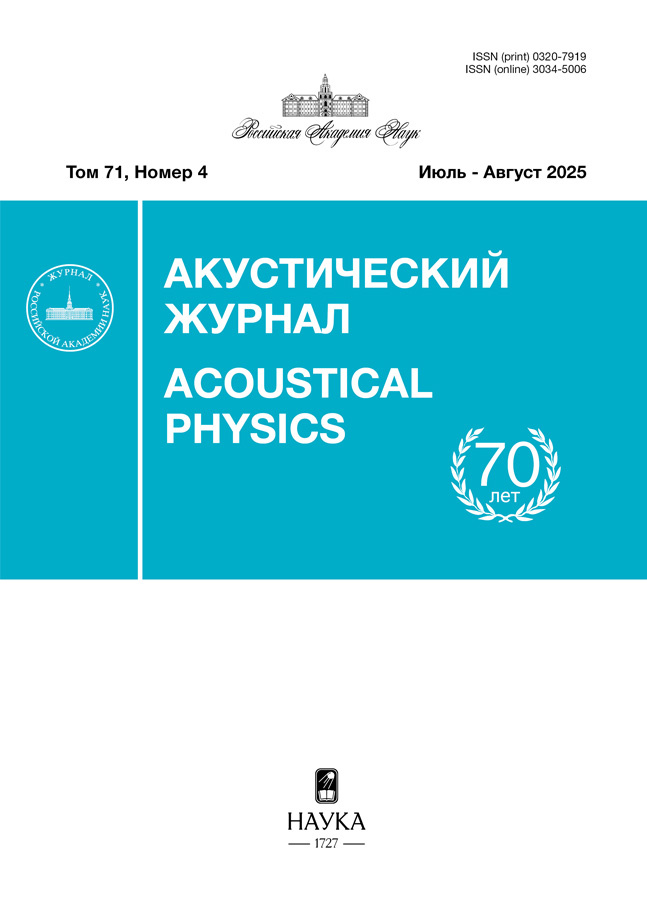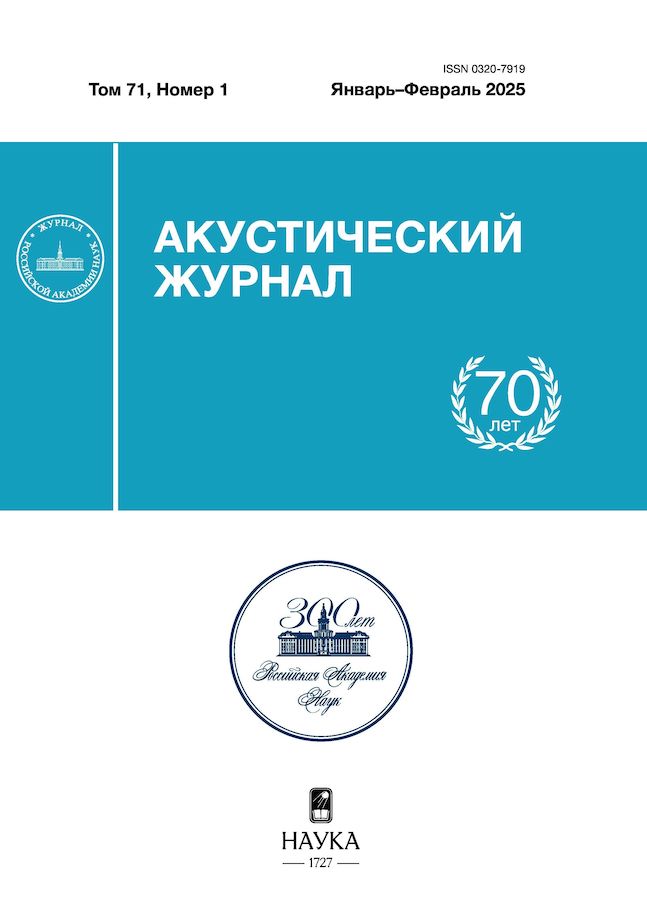Характеристики низкочастотного окружающего шума в мелком море с неоднородной структурой дна
- Авторы: Боджона С.Д.1, Сидоров Д.Д.1, Петников В.Г.1, Луньков А.А.1,2
-
Учреждения:
- Институт общей физики им. А.М. Прохорова РАН
- Московский государственный технический университет им. Н.Э. Баумана
- Выпуск: Том 71, № 1 (2025)
- Страницы: 79-87
- Раздел: АКУСТИКА ОКЕАНА. ГИДРОАКУСТИКА
- URL: https://vestnik.nvsu.ru/0320-7919/article/view/683640
- DOI: https://doi.org/10.31857/S0320791925010091
- EDN: https://elibrary.ru/BQKDQZ
- ID: 683640
Цитировать
Полный текст
Аннотация
В рамках численных экспериментов анализируются характеристики низкочастотных шумовых полей в мелководных акустических волноводах с неоднородной структурой донных осадков, в том числе и в присутствии водоподобного дна. Рассматриваются две модели морского дна: идеализированная, с линейным изменением скорости звука в дне вдоль одной из декартовых координат, и реалистичная, где скорость звука в дне зависит от всех трех координат. Последняя модель близка к реальной ситуации в одном из мелководных районов Карского моря. Исследуются шумовые поля от распределенных приповерхностных источников (поверхностное волнение) и сосредоточенного источника (шум судна). Расчеты выполнены с помощью метода широкоугольного параболического уравнения. Получены усредненные горизонтальные и вертикальные характеристики направленности шумового поля поверхностного волнения, а также средние значения интенсивности в зависимости от положения приемной вертикальной антенны и частоты звука. Для областей дна с отличающимися свойствами построены пространственные зависимости уровня локального источника шума. Продемонстрирована возможность обнаружения водоподобных участков дна по записи шума движущегося судна на стационарную вертикальную акустическую антенну. В случае распределенных источников показано, что усредненные характеристики шума слабо зависят от скорости звука в дне.
Полный текст
Об авторах
С. Д. Боджона
Институт общей физики им. А.М. Прохорова РАН
Автор, ответственный за переписку.
Email: bodjona@kapella.gpi.ru
Россия, ул. Вавилова 38, Москва, 119991
Д. Д. Сидоров
Институт общей физики им. А.М. Прохорова РАН
Email: sidorov@kapella.gpi.ru
Россия, ул. Вавилова 38, Москва, 119991
В. Г. Петников
Институт общей физики им. А.М. Прохорова РАН
Email: petniko@kapella.gpi.ru
Россия, ул. Вавилова 38, Москва, 119991
А. А. Луньков
Институт общей физики им. А.М. Прохорова РАН; Московский государственный технический университет им. Н.Э. Баумана
Email: lunkov@kapella.gpi.ru
Россия, ул. Вавилова 38, Москва, 119991; ул. 2-Бауманская 5, Москва, 105005
Список литературы
- Малашенков Б.М., Акчурин Л.И. Проблемы и перспективы разработки нефтегазовых месторождений на арктическом шельфе Российской Федерации // Вестник Московского университета. Сер. 21. Управление (государство и общество). 2015. № 2. С. 49–64.
- Газарян Ю.Л. Об энергетическом спектре шума в плоскослоистых волноводах // Акуст. журн. 1975. Т. 21. № 3. С. 382–389.
- Аредов А.А., Дронов Г.М., Фурдуев А.В. Влияние ветра и внутренних волн на параметры шума океана // Акуст. журн. 1990. Т. 36. № 4. С. 581.
- Ingenito F., Wolf S.N. Site dependence of wind-dominated ambient noise in shallow water // J. Acoust. Soc. Am. 1989. V. 85. № 1. P. 141–145.
- Григорьев В.А., Петников В.Г., Росляков А.Г., Терёхина Я.Е. Распространение звука в мелком море с неоднородным газонасыщенным дном // Акуст. журн. 2018. Т. 64. № 3. С. 342–358.
- Grigor’ev V.A., Lunkov A.A., Petnikov V.G. Effect of sound-speed inhomogeneities in sea bottom on the acoustic wave propagation in shallow water // Physics of Wave Phenomena. 2020. V. 28. P. 255–266.
- Petnikov V.G. et al. Modeling underwater sound propagation in an arctic shelf region with an inhomogeneous bottom // J. Acoust. Soc. Am. 2022. V. 151. № 4. P. 2297–2309.
- Yang T.C., Yoo K. Modeling the environmental influence on the vertical directionality of ambient noise in shallow water // J. Acoust. Soc. Am. 1997. V. 101. № 5. P. 2541–2554.
- Katsnelson B., Petnikov V., Lynch J. Fundamentals of shallow water acoustics. New York: Springer, 2012. V. 1.
- Сидоров Д.Д., Петников В.Г., Луньков А.А. Широкополосное звуковое поле в мелководном волноводе с неоднородным дном // Акуст. журн. 2023. Т. 69. № 5. С. 608–619.
- Зверев В.А. Избранные труды. Н. Новгород: Институт прикладной физики РАН, 2004.
- Зверев В.А. Формирование изображений акустических источников в мелком море. Н. Новгород: ИПФ РАН, 2019. 112 с.
- Carey W.M., Evans R.B. Ocean ambient noise: measurement and theory. Springer Science & Business Media, 2011.
- Collins M.D. A split-step Padé solution for the parabolic equation method // J. Acoust. Soc. Am. 1993. V. 93. № 4. P. 1736–1742.
- Wilson J.H. Wind-generated noise modeling // J. Acoust. Soc. Am. 1983. V. 73. № 1. P. 211–216.
- Leigh C.V., Eller A.I. Dynamic ambient noise model comparison with Point Sur, California, in situ data // Contract. 2006. V. 24. № 02-D. P. 6602.
- Heaney K.D. Rapid geoacoustic characterization using a surface ship of opportunity // IEEE J. Oceanic Engineering. 2004. V. 29. № 1. P. 88–99.
- Завольский Н.А., Раевский М.А. Горизонтальная анизотропия динамических шумов в глубоком и мелком море // Акуст. журн. 2019. Т. 65. № 2. С. 197–202.
Дополнительные файлы


















